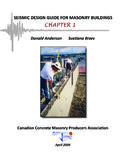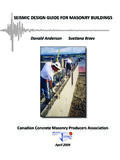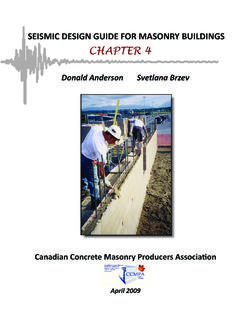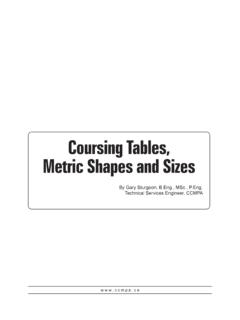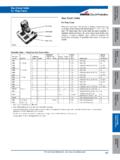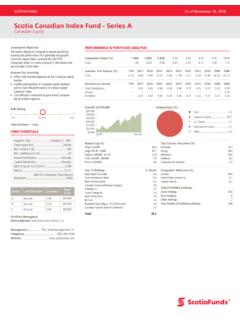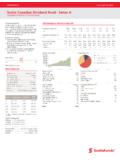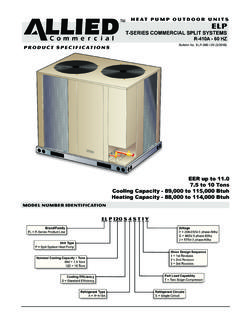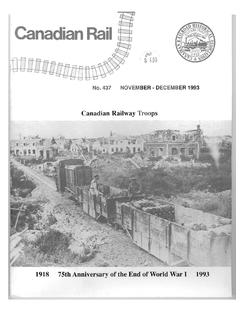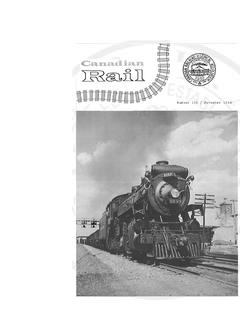Transcription of Canadian Concrete Masonry Producers’ …
1 Canadian Concrete Masonry producers MasonryDesign GuidelinesCanadian Concrete Masonry producers AssociationEmpirical Masonry Design Guidelinesw c m DESIGN FOR Masonry BUILDINGS8-1 INTRODUCTIONThe empirical or Conventional Design for Masonry isbased on a simplified analysis of the loads and forcesacting on the structure. When this approach is utilized,the limitations of height, load location, seismic zone,wind loading, the size of any openings and lateral sup-port requirements must be resulting from this type of procedure are oftendescribed by such phrases as deemed to performbased on long-term experience.
2 Engineered Analysis, results in a more cost effectivestructure in many instances and must be used wheneverthe limitations are chapter is a commentary on selected detailsof Clause 16, Masonry Design for Buildings(Limit States Design) does not purportto be a total design Concrete Masonry producers AssociationEmpirical Masonry Design Canadian Concrete Masonry producers association gratefully acknowledges the contributionsof the following:Dr. Drysdale, PhD., University, HamiltonR. Jiran, Branch, City of Shirlaw, Portland Cement association , Toronto, OntarioThis "Guide" is intended to facilitate the use of Concrete block construction in accordance with , Masonry Design for Buildings, (Limit States Design)
3 Clause 16 While all possible care has been taken to ensure that the information contained herein is accurateneither the Canadian Concrete Masonry producers association nor any of the contributors can accept responsibility for any errors or Concrete Masonry producers AssociationEmpirical Masonry Design empirical Rules can be used for non-reinforcedMasonry height of loadbearing walls above the firststorey floor does not exceed 11 height of exterior non-loadbearing walls abovegrade does not exceed 20 metres and the 1 in 30years wind pressure does not exceed kN/m2.
4 (Refer to Table , Ontario Building Code, forapplicable data). walls are not subject to lateral Ontario Building Code ( ) allows limitedusage on basis of "deems to" proven,performance. (See Figure ) structure is not subjected to lateral pressureother than wind resultant vertical force of a load falls within themiddle third of the wall thickness. (See Figure ) is located within seismic zones 0 and1. (Refer to Table Ontario Building Code,for applicable data). empirical Rules can only be used for plain,non-reinforced Masonry .
5 Note that joint reinforcingfor bonding or crack control and reinforcing insecondary structural elements such as short spanlintels, does not invalidate this design `A' and `B' fall within empirical `C' requires Engineered AnalysisFigure 1 MIDDLE THIRD RULEC anadian Concrete Masonry producers AssociationEmpirical Masonry Design GuidelinesALLOWABLE COMPRESSIVE the purposes of Table `A', the conversion from Netto Gross Area strength of standard units is as follows:See Tables `B' and `C' for allowable loads on standardstrength units.
6 15 MPa net is the standard strengthavailable from CCMPA Members See Section Units with a strength of 20 MPa and over areavailable on a made to order Masonry is constructed of different types orgrades of units or mortar, the allowable stress shall bebased on the weakest the wythes of a cavity wall are of differenttypes of material, it is recommended that only onewythe be loaded. Where only one wythe is loaded, the allowable stress shall be based on the MASONRY20 MPa & overSolid - 20 MPaHollow MPaCAVITYWALLS olid MPaHollow MPaSNMORTARTYPESTABLE A.
7 MAXIMUM ALLOWABLE COMPRESSIVE STRESSFOR NON-REINFORCED Concrete MASONRYBASED ON GROSS CROSS-SECTIONAL AREA (MPa)WALLTYPESUNIT TYPENET MPaGROSS allowable compressive stresses on Masonry ,based on gross cross-sectional area, are given in Table7 in Where concentrated loads occur,Clause allows maximum stresses to beincreased by 25% (But the total load on the masonrycannot exceed value allowable).Note that the latest specification for Concrete , designates strengths in terms of net Concrete Masonry producers AssociationEmpirical Masonry Design TYPENSUNIT TYPE(15 MPa)ALLOWABLESTRESS MPaUNIT B:ALLOWABLE LOADS FOR SOLID or SINGLE WYTHE Masonry (Standard Strength Concrete Block) (kN/m)TABLE C.
8 ALLOWABLE LOADS FOR LOADED CAVITY WYTHE 2(Standard Strength Concrete Block) (kN/m)MORTAR TYPENSUNIT TYPE(15 MPa)ALLOWABLESTRESS MPaUNIT Unit means a structural Masonry unit with a net cross sectional area of at least 75% of its gross cross sectional area in any plane parallel to its bearing the exterior wythe is designed as a veneer, the values in Table `B' may be used for the loadbearing Concrete Masonry producers AssociationEmpirical Masonry Design D:ALLOWABLE COMBINED LOADS FOR BOTH WYTHES (kN/m)(Standard Strength Concrete Block)MORTAR TYPENSUNIT TYPE(15 MPa)ALLOWABLESTRESS ++++++90140190240290 TABLE E:ALLOWABLE LOADS FOR HIGH STRENGTH SOLID UNITS(> 20 MPa)1 (kN/m)MORTAR TYPENSALLOWABLESTRESS F:WALL WEIGHT & MASS FOR STANDARD WEIGHT UNITS (2100 kg/m3)MORTAR TYPEWALL MASS(kg/m2)WALL WEIGHT(kg/m2)ALLOWABLESTRESS MPaUNITSIZEH ollow13817022326731075% High strength units are available on a made to order basis.
9 Wall weight = mass x 1000 Canadian Concrete Masonry producers AssociationEmpirical Masonry Design GuidelinesLateral Masonry means Masonry of solid or hollow units that does not have cavities between the wythes, single wythe Masonry is included in this height or length of wall between horizontal or vertical lateral thickness may be reduced; the 140mm solid Masonry unit can be useda)in loadbearing applications, the maximum height at eave is and at the gable (See Figure )b)in exterior, non-loadbearing applications, with a maximum height of 3m but Type `S' mortar is partitions in buildings with small exterior openings or with unbalanced air pressures not exceeding 24 G.
10 HEIGHT & THICKNESS OF SOLID MASONRY1 TYPE OFWALLLOADBEARING(Solid or Hollow Units)EXTERIORNON-LOADBEARING(Solid or Hollow Units)PARTITIONS4 MAXIMUMh/t2 HEIGHT/THICKNESS RATIO h/t22019090 11 metres2019075 20 metres36757572 x actual thicknessMINIMUM WALLt3(mm)MINIMUM WYTHEt (mm)MAXIMUM TOTALHEIGHTL ateral support must be provided at either horizontal or vertical intervals not exceeding 20 times the actual wallthickness (t) except as partition walls, lateral support is required at cavity walls, the wall thickness shall be based on two thirds (2/3) the sum of both wythes but not lessthan the thickness of either wythe.
